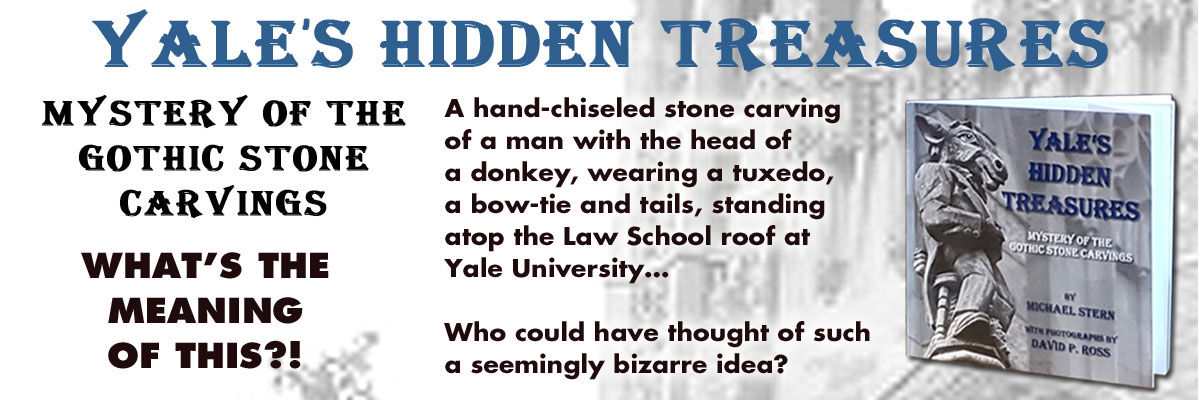A hand-chiseled stone carving of a man with the head of a donkey, wearing a tuxedo, a bow-tie and tails, standing atop the law school roof of an elite Ivy League University…
Who could have thought of such a seemingly bizarre idea? Why are literally dozens of unusual stone figures found on several of Yale University’s Gothic style buildings? How were they done, and more importantly, why were they done? Many of them are comical and appear to be done almost as an intentional joke on the part of the architect or the University itself. This might be the case if it weren’t for the fact that each figure has a special significance associated with education at Yale. Still others are satirical, poking fun at various aspects of higher education and life in general. Over the years, Yale has been known for the “controversial” and some of these carvings echo that. How many people really know about them, and what do they know?
Another oddity is that many of these stone carvings are located on the high elevations of steeples and bell towers, while others are somewhat obscured by tree limbs. There are many smaller sized heads of Yale dignitaries that literally require binoculars to be seen from street level. Situated on the peaks of gables along the rear roof line of the Law Building are seven, three-foot high carvings of men with the heads of animals. These figures tend to blend right into the walls behind them, as all are made of the exact same stone. This part of the building, which gets very little sunlight, also
makes these particular figures quite difficult to see from the sidewalk. It’s as though the architect really didn’t want some of these carvings to be easily seen. If so, why? Were they intentionally hidden in plain sight?
It's often been said "If these walls could only speak" or "I'd love to have been a fly on the wall" in reference to so many occurrences that have taken place in a room that years later people were never privy to. Many of Yale's stone carvings not only have ears but eyes as well. They also have mouths that unfortunately will never speak. One can only imagine all that they have born silent witness to over the past one hundred years since being hand chiseled in stone. They have heard future U.S. presidents and some of the greatest intellectuals of our time carrying on brilliant conversations as they strolled by these magnificent carvings. They have also witnessed some violent political demonstrations and riots that have taken place on the Yale campus during the turbulent 1960's. They will witness much more before turning to dust or being destroyed by future forces not yet known.
James Gamble Rogers, who has been described as stoic, had another distinct side to him. His alter ego came to life in the comical, satirical stone carvings that he created on Yale’s Gothic style campus buildings. He never revealed why he created these carvings or what any of them meant. None of his other buildings were ornamented with the likes of such carvings. One could speculate that he intended for his stone carvings to carry on the Yale mystique that had begun with the formation of its secret societies years earlier and speculation gives rise to questions.
This book is devoted to the study of the stone carvings on the exterior of these buildings that face the street and the inner courtyards. It provides insight and information while presenting dynamic photographs of these intriguing figures. As revealed in subsequent pages, many of the stone carvings are far more than inanimate objects. Due to their satirical significance, they tend to take on a life of their own. Some of them are silently speaking to us with their own messages to convey. Many of them reveal stories of Yale folklore. With some curiosity and a little imagination, many interested passersby might be able to draw their own conclusions as to their real meaning. The history behind some of them may never be known. Indeed, the meaning of some may be left to the imagination of past, current and future generations. These masterful sculptures from a bygone era of stone masonry could be one of the University’s best-kept secrets and are part of what makes Yale so unique.
